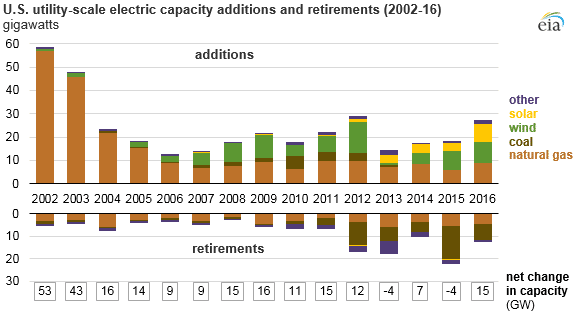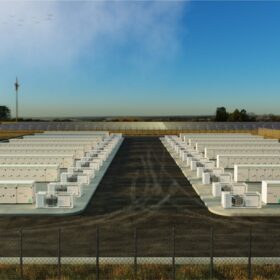While the U.S. solar market continues to grow rapidly, solar generation still represented a tiny share of the nation’s overall electricity, according to the latest figures from the U.S. Department of Energy’s Energy Information Administration (EIA)
The latest edition of EIA’s Electric Power Monthly shows that the portion of electricity that the nation gets from solar grew nearly 40% in 2016, from around 1% of total generation to 1.4%. Wind is likewise growing, with the share of electricity from wind rising from 4.7% in 2015 to 5.5% of all generation last year.
And while these are relatively low shares, solar and wind made up more than 60% of new generation put online last year by capacity.

Boosted by the growing share of solar and wind, 2016 serves as the second year where non-hydro renewable sources generated more electricity than hydroelectric plants. This likewise brought the overall share of renewable energy in the nation’s generation to 15.3% during the year.
The share of both solar and all renewables in the United States is well behind that of most nations in Western Europe, and this is largely because solar and wind deployment in concentrated in a few states and regions. Hawaii, California, North Carolina and Arizona and New Jersey boast higher than average portions of solar in their electricity mixes, however despite recent progress many states are still behind, including large energy users like Texas, Florida and Illinois.
Wind development has likewise been highly regional. Last year Texas got 15% of its power from wind, and California and states in the Great Plains including Iowa have been national leaders. However wind development is still limited east of the Mississippi, especially in the U.S. South which has poor land-based wind resources.
This may be changing, and New York in particular has seen a boom in solar deployment in the last few years. Also, it is important to note that generation figures always lag installations. With an estimated 14.6 GW of solar installed in 2016, 2017 would see at least 2% of U.S. electricity generation from solar, even if no projects were put online this year.
This content is protected by copyright and may not be reused. If you want to cooperate with us and would like to reuse some of our content, please contact: editors@pv-magazine.com.








At this rate of growth where will solar be in 10 years? In 15?
Great question. It’s hard to say. 2016 was an exceptional year due to scheduled expiration and then extension of the ITC, and the rate of solar market growth has swung wildly over the past five years, from 16% 2014-2015 to 95% 2015-2016. In 2017 all major market analysts expect the rate of growth to fall again, and we could even have the first contraction of the U.S. solar market that we’ve seen in well over a decade.
However, if we average growth rates for the last five years, we get 52% – a doubling more than every two years. If that continues, that would mean ~300 GW more solar installed through the end of 2021, a 10-fold increase on today’s capacity. If electric demand remains relatively constant, as it has for the last decade, that would mean solar would be supplying more in the order of 15-16% of all electricity around 2021-2022.
Unless electricity demand grows – and it hasn’t since 2010 – we won’t see that growth rate over a full 10 years, because solar would then supply more electricity than our entire demand. Mass deployment of electric vehicles would definitely increase electricity demand, but it is hard to predict when that will happen.
My general expectation is that the rate of growth will fall somewhat over the next 10 years, but I cannot say how much or in what timeframe. One factor to consider here is that with the current rate of growth we will run out of suitable rooftops for solar at some point in the next 5-10 years, and everything after that will have to be deployed somewhere else. Also, at some point we are going to need massive energy storage and/or electric vehicle deployment if we are going to be able to make use of high penetrations of solar (and wind), and the changes to the market are already not pretty for the established power companies, who have no idea how to operate in an environment of extremely low wholesale power prices and high levels of zero-marginal cost generation.